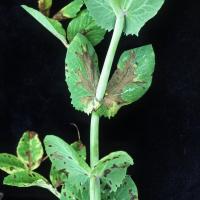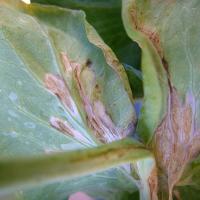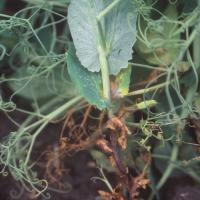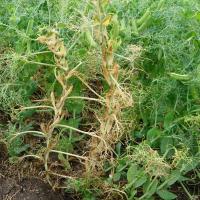Diagnosing bacterial blight in field peas
Bacterial Blight (Pseudomonas syringae pv.pisi) is rarely seen in Western Australia. Field pea growers in Western Australia who retain their own seed, or source it from within the state, are unlikely to encounter this disease.
What to look for
- Infections usually occur in small patches where bacteria are splashed to adjoining plants from the initial infection.
Paddock
- Bacterial blight first appears as small, dark green, water-soaked spots on leaves and stipules, often near the leaf base. The spots enlarge and merge but are often limited by the veins.
- The leaf spots turn yellowish and later brown and papery.
- Spots on pods are sunken and olive brown.
- Spots can develop on the stem near ground level. These begin as water-soaked areas that later turn to olive-green to dark brown. spots can merge causing the stem to shrivel and die.
Plant
What else could it be
| Condition | Similarities | Differences |
|---|---|---|
| Diagnosing septoria in field peas | Pale brown leaf lesions | Fruiting bodies in lesions |
Where did it come from?

Contaminated stubble

Contaminated seed
- The bacteria that cause blight are carried on plant residues and seed from diseased crops.
- The most likely source of infection for field pea growers in Western Australia is through introduction with seed purchased from southeastern Australia. During wet weather the disease is spread from infected plants to healthy plants by rain splash and wind borne water droplets. Since the disease needs wet conditions to spread, blight is most severe in wet conditions.
- The bacteria needs a damaged area on the plant where it can enter. Hail, frost or machinery passing through the crop can cause this damage and hence create entry points for the bacteria.
Management strategies
- The most effective way to manage this disease in Western Australia is to ensure that seed sourced from outside the State is tested and certified as disease free. If a crop becomes infected with bacterial blight it is unlikely the disease will affect yield.
See also
Further information
Where to go for expert help
Page last updated: Wednesday, 13 May 2015 - 1:36pm





